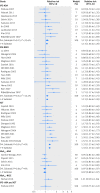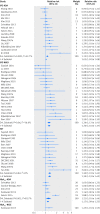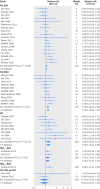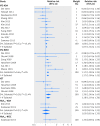Association between prediabetes and risk of cardiovascular disease and all cause mortality: systematic review and meta-analysis
- PMID: 27881363
- PMCID: PMC5121106
- DOI: 10.1136/bmj.i5953
Association between prediabetes and risk of cardiovascular disease and all cause mortality: systematic review and meta-analysis
Abstract
Objectives: To evaluate associations between different definitions of prediabetes and the risk of cardiovascular disease and all cause mortality.
Design: Meta-analysis of prospective cohort studies.
Data sources: Electronic databases (PubMed, Embase, and Google Scholar).
Selection criteria: Prospective cohort studies from general populations were included for meta-analysis if they reported adjusted relative risks with 95% confidence intervals for associations between the risk of composite cardiovascular disease, coronary heart disease, stroke, all cause mortality, and prediabetes.
Review methods: Two authors independently reviewed and selected eligible studies, based on predetermined selection criteria. Prediabetes was defined as impaired fasting glucose according to the criteria of the American Diabetes Association (IFG-ADA; fasting glucose 5.6-6.9 mmol/L), the WHO expert group (IFG-WHO; fasting glucose 6.1-6.9 mmol/L), impaired glucose tolerance (2 hour plasma glucose concentration 7.8-11.0 mmol/L during an oral glucose tolerance test), or raised haemoglobin A1c (HbA1c) of 39-47 mmol/mol : (5.7-6.4%) according to ADA criteria or 42-47 mmol/mol (6.0-6.4%) according to the National Institute for Health and Care Excellence (NICE) guideline. The relative risks of all cause mortality and cardiovascular events were calculated and reported with 95% confidence intervals.
Results: 53 prospective cohort studies with 1 611 339 individuals were included for analysis. The median follow-up duration was 9.5 years. Compared with normoglycaemia, prediabetes (impaired glucose tolerance or impaired fasting glucose according to IFG-ADA or IFG-WHO criteria) was associated with an increased risk of composite cardiovascular disease (relative risk 1.13, 1.26, and 1.30 for IFG-ADA, IFG-WHO, and impaired glucose tolerance, respectively), coronary heart disease (1.10, 1.18, and 1.20, respectively), stroke (1.06, 1.17, and 1.20, respectively), and all cause mortality (1.13, 1.13 and 1.32, respectively). Increases in HBA1c to 39-47 mmol/mol or 42-47 mmol/mol were both associated with an increased risk of composite cardiovascular disease (1.21 and 1.25, respectively) and coronary heart disease (1.15 and 1.28, respectively), but not with an increased risk of stroke and all cause mortality.
Conclusions: Prediabetes, defined as impaired glucose tolerance, impaired fasting glucose, or raised HbA1c, was associated with an increased risk of cardiovascular disease. The health risk might be increased in people with a fasting glucose concentration as low as 5.6 mmol/L or HbA1c of 39 mmol/mol.
Published by the BMJ Publishing Group Limited. For permission to use (where not already granted under a licence) please go to http://group.bmj.com/group/rights-licensing/permissions.
Conflict of interest statement
All author shave completed the ICMJE uniform disclosure form at www.icmje.org/coi_disclosure.pdf (available on request from the corresponding author) and declare: no support from any organisation for the submitted work; no financial relationships with any organizations that might have an interest in the submitted work in the previous three years; no other relationships or activities that could appear to have influenced the submitted work.
Figures





Comment in
-
Prediabetes Increases Risk of Cardiovascular Disease.Am J Nurs. 2017 Jun;117(6):71. doi: 10.1097/01.NAJ.0000520262.18448.1c. Am J Nurs. 2017. PMID: 28541998 No abstract available.
References
-
- DeFronzo RA, Abdul-Ghani M. Assessment and treatment of cardiovascular risk in prediabetes: impaired glucose tolerance and impaired fasting glucose. Am J Cardiol 2011;108(Suppl):3B-24B. 10.1016/j.amjcard.2011.03.013. pmid:21802577. - DOI - PubMed
-
- World Health Organization (WHO) Consultation. Definition and diagnosis of diabetes and intermediate hyperglycaemia.2006http://www.who.int/diabetes/publications/Definition%20and%20diagnosis%20....
-
- Expert Committee on the Diagnosis and Classification of Diabetes Mellitus. Report of the expert committee on the diagnosis and classification of diabetes mellitus. Diabetes Care 2003;26(Suppl 1):S5-20. 10.2337/diacare.26.2007.S5. pmid:12502614. - DOI - PubMed
-
- Rydén L, Grant PJ, Anker SD, et al. Authors/Task Force Members ESC Committee for Practice Guidelines (CPG) Document Reviewers. ESC Guidelines on diabetes, pre-diabetes, and cardiovascular diseases developed in collaboration with the EASD: the Task Force on diabetes, pre-diabetes, and cardiovascular diseases of the European Society of Cardiology (ESC) and developed in collaboration with the European Association for the Study of Diabetes (EASD). Eur Heart J 2013;34:3035-87. 10.1093/eurheartj/eht108. pmid:23996285. - DOI - PubMed
-
- Forouhi NG, Balkau B, Borch-Johnsen K, et al. EDEG. The threshold for diagnosing impaired fasting glucose: a position statement by the European Diabetes Epidemiology Group. Diabetologia 2006;49:822-7. 10.1007/s00125-006-0189-4. pmid:16525842. - DOI - PubMed
Publication types
MeSH terms
LinkOut - more resources
Full Text Sources
Other Literature Sources
Medical
Research Materials
Miscellaneous
